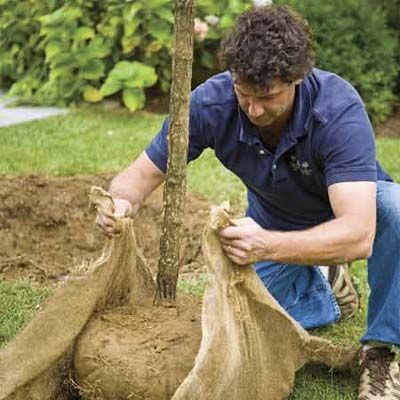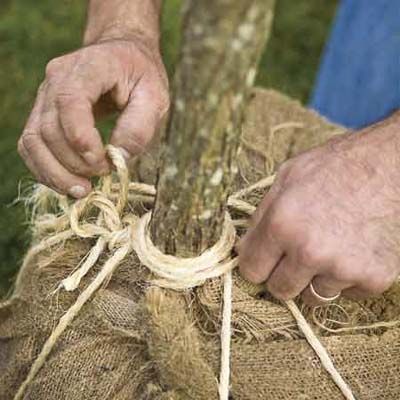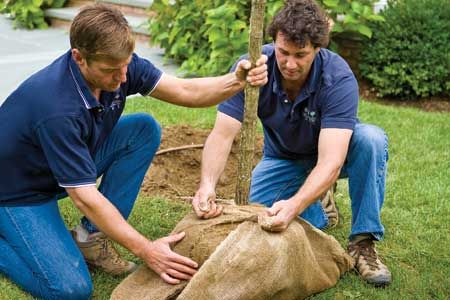Project details
Skill
Cost
Estimated Time
 Spade
Spade
Moving a small tree isn’t too complicated. A successful transplant, temporary or not, depends on having an intact root ball of sufficient size – about 11 times the trunk’s diameter. If the trunk is more than 3½ inches across, call in a professional landscaper because of the weight involved. Once the tree is dug up, its roots get wrapped in burlap and twine to hold the soil. The tree can then be transported and kept alive until replanting time.
To tie up the 18-inch-diameter ball shown above, we used a 42-by-42-inch piece of two-ply burlap and about 6 yards of sisal twine, both available at garden stores. Even for a tree this small, the work is much easier with two people. It’s important to tie the burlap and sisal tightly around the ball, but take care not to rub them against the trunk because you can easily damage the young tree’s delicate bark.
Properly swaddled and regularly watered, a tree will easily survive for months out of the ground, until you’re ready to plant it for good. Transplanting a small tree isn’t too complex. It’s much simpler than adding a new room to your home or relocating to a new country.
Follow the steps below to see how to transplant a tree successfully.
Step 1
Dig out the root ball

Use a spade to slice a circle in the ground around the tree that’s as deep as the blade and 11 times the trunk’s diameter. Outside this circle, dig a wide trench; keep digging until you stop encountering roots. Work the spade under the ball at a shallow angle until it’s free. Carefully slide the burlap under the ball, grasp the fabric, and lift the tree out of its hole.
Step 2
Wrap the roots

Position the root ball in the center of the burlap and gently lift its opposite corners. Use a square knot to tie the opposite sides together as tightly as you can next to the trunk. Do the same with the burlap’s other two free corners.
Step 3
Truss the twine

Tie one end of twine loosely to the trunk, then wrap it vertically around the ball. Tilt the tree gently so that each loop passes under the ball’s bottom. Never wrap twine all the way around the trunk. When you’re done, the twine should be evenly spaced and no more than 6 inches apart at the ball’s widest spot.
Step 4
Tie and Replace

4. Tie and relocate
Tie the end of the twine to one of the vertical loops using a rolling-hitch knot (see Animated Knots). Only now is it safe to relocate the tree. You don’t want the root ball to dry out during its sojourn, so cover it with wood chips and water it thoroughly and regularly—about every other day in a warm weather.


